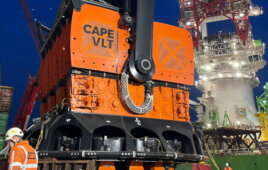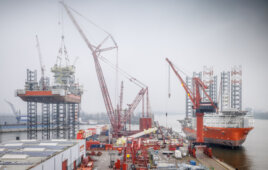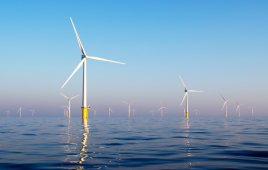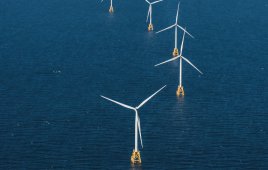Until now, laser based, wind-measuring equipment mounted on nacelles has been heavy, expensive, and difficult to install. But doing so provided a more accurate wind speed and direction than that from anemometers mounted downwind on nacelles. France-based Epsiline wants to improve the current equipment with a lidar unit that lighter than existing designs, easy to install, and less expensive. What’s more, says Mireille Focquet, company Business Development Partner for North America, “correcting the frequently encountered yaw error on many turbines provides an ROI on the equipment in as little as two to three years.” Yaw error is the offset between actual wind direction and where the turbine is pointing.

Epsiline’s Yaw Advisor is a turbine mounted, laser-based wind sensor that accurately measure wind direction immediately in front of a wind turbine. Measuring wind direction ahead of the rotor avoids disruptive wind turbulence in the traditional measurement zone behind the blades.
Yaw Advisor, Epsiline’s 66-lb laser-based wind sensor aims only at measuring the yaw error of wind turbines and correcting the drawbacks of the current lidar wind sensors. Accurate and precise wind data will let owners and operators update their operation strategies.
Measuring wind speed and direction with lasers is based on the well-known principle of the Doppler Effect: Laser beams are reflected by particles of dust and pollen carried by the wind. A small portion of the reflected light is collected and processed to derive the radial velocity of the particle. This information is used to calculate the wind direction.
The idea is for operators to compare Yaw Advisor data to SCADA records. A difference in readings would be the misalignment, and can be up to several degrees. “We provide the tools to find the offset, but do not make the control adjustment. The information will let owners and operators make more informed decisions,” says Focquet. “Research indicates that the magnitude of yaw errors can vary depending on the wind direction and speed. What’s more, constructing a wind farm even 10 miles upwind can produce changes at downstream wind farms.”
She says that Yaw Advisor installs easily in about two to three hours on most wind turbines and less than that when the crew is experienced. “It’s meant to be a diagnostic tool installed for two to three weeks and then moved to another turbine, or returned when leased. It does not control the turbine, it only collects data.”
Once wind techs correct the yaw error on a turbine, they can expect to see increased productivity and efficiency, and higher revenues. Lower yaw error also reduces loads on turbine mechanisms and components and so lowers maintenance and repairs costs.
The company says it built the unit in the smallest size possible and rounded the design to minimize the flow distortion. In addition, the unit consumes little power even with the heating element.
Focquet adds that units will be available for sale or lease in 2016, and the price point is set low enough that maintenance companies can provide it in their service offering, or wind farm owners can lease or purchase the device. What’s more, the company is working for DNV GL and ISO 9001 certifications by 2016.
Filed Under: News, O&M




